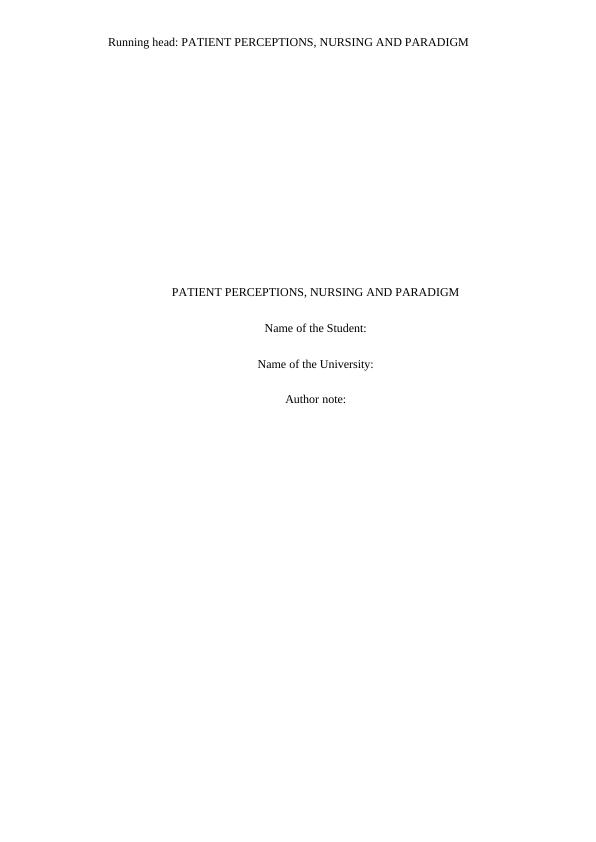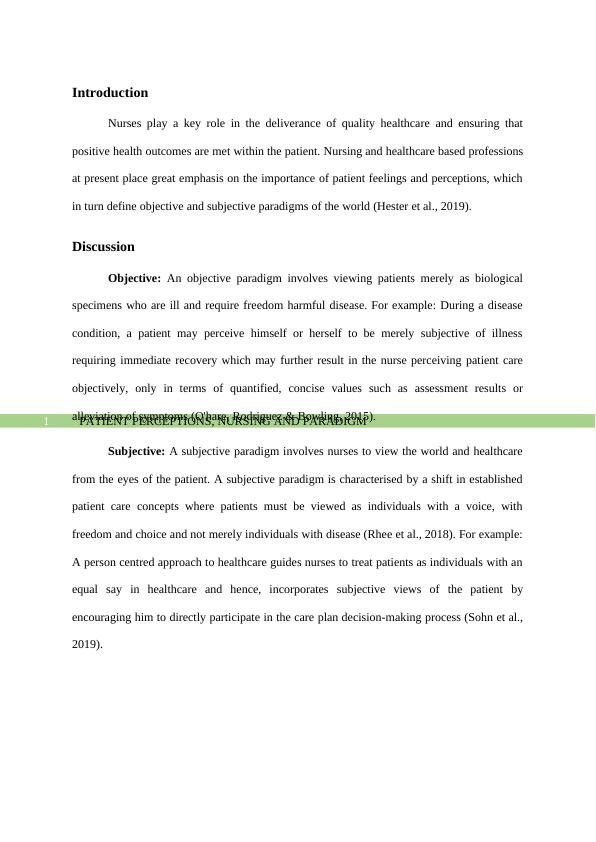Patient Perceptions, Nursing and Paradigm
Added on 2022-11-26
4 Pages546 Words162 Views
Running head: PATIENT PERCEPTIONS, NURSING AND PARADIGM
PATIENT PERCEPTIONS, NURSING AND PARADIGM
Name of the Student:
Name of the University:
Author note:
PATIENT PERCEPTIONS, NURSING AND PARADIGM
Name of the Student:
Name of the University:
Author note:

PATIENT PERCEPTIONS, NURSING AND PARADIGM1
Introduction
Nurses play a key role in the deliverance of quality healthcare and ensuring that
positive health outcomes are met within the patient. Nursing and healthcare based professions
at present place great emphasis on the importance of patient feelings and perceptions, which
in turn define objective and subjective paradigms of the world (Hester et al., 2019).
Discussion
Objective: An objective paradigm involves viewing patients merely as biological
specimens who are ill and require freedom harmful disease. For example: During a disease
condition, a patient may perceive himself or herself to be merely subjective of illness
requiring immediate recovery which may further result in the nurse perceiving patient care
objectively, only in terms of quantified, concise values such as assessment results or
alleviation of symptoms (O'hare, Rodriguez & Bowling, 2015).
Subjective: A subjective paradigm involves nurses to view the world and healthcare
from the eyes of the patient. A subjective paradigm is characterised by a shift in established
patient care concepts where patients must be viewed as individuals with a voice, with
freedom and choice and not merely individuals with disease (Rhee et al., 2018). For example:
A person centred approach to healthcare guides nurses to treat patients as individuals with an
equal say in healthcare and hence, incorporates subjective views of the patient by
encouraging him to directly participate in the care plan decision-making process (Sohn et al.,
2019).
Introduction
Nurses play a key role in the deliverance of quality healthcare and ensuring that
positive health outcomes are met within the patient. Nursing and healthcare based professions
at present place great emphasis on the importance of patient feelings and perceptions, which
in turn define objective and subjective paradigms of the world (Hester et al., 2019).
Discussion
Objective: An objective paradigm involves viewing patients merely as biological
specimens who are ill and require freedom harmful disease. For example: During a disease
condition, a patient may perceive himself or herself to be merely subjective of illness
requiring immediate recovery which may further result in the nurse perceiving patient care
objectively, only in terms of quantified, concise values such as assessment results or
alleviation of symptoms (O'hare, Rodriguez & Bowling, 2015).
Subjective: A subjective paradigm involves nurses to view the world and healthcare
from the eyes of the patient. A subjective paradigm is characterised by a shift in established
patient care concepts where patients must be viewed as individuals with a voice, with
freedom and choice and not merely individuals with disease (Rhee et al., 2018). For example:
A person centred approach to healthcare guides nurses to treat patients as individuals with an
equal say in healthcare and hence, incorporates subjective views of the patient by
encouraging him to directly participate in the care plan decision-making process (Sohn et al.,
2019).

End of preview
Want to access all the pages? Upload your documents or become a member.
